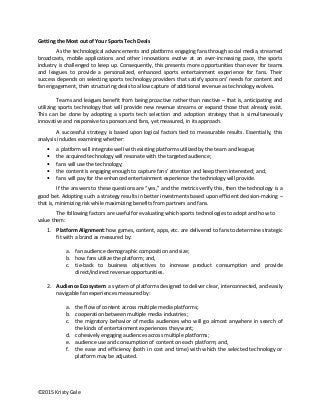Getting the Most out of Your Sports Tech Deals 0915
- 1. ©2015 Kristy Gale
Getting the Most out of Your Sports Tech Deals
As the technological advancements and platforms engaging fans through social media, streamed
broadcasts, mobile applications and other innovations evolve at an ever-increasing pace, the sports
industry is challenged to keep up. Consequently, this presents more opportunities than ever for teams
and leagues to provide a personalized, enhanced sports entertainment experience for fans. Their
success depends on selecting sports technology providers that satisfy sponsors’ needs for content and
fan engagement, then structuring deals to allow capture of additional revenue as technology evolves.
Teams and leagues benefit from being proactive rather than reactive – that is, anticipating and
utilizing sports technology that will provide new revenue streams or expand those that already exist.
This can be done by adopting a sports tech selection and adoption strategy that is simultaneously
innovative and responsive to sponsors and fans, yet measured, in its approach.
A successful strategy is based upon logical factors tied to measurable results. Essentially, this
analysis includes examining whether:
• a platform will integrate well with existing platforms utilized by the team and league;
• the acquired technology will resonate with the targeted audience;
• fans will use the technology;
• the content is engaging enough to capture fans’ attention and keep them interested; and,
• fans will pay for the enhanced entertainment experience the technology will provide.
If the answers to these questions are “yes,” and the metrics verify this, then the technology is a
good bet. Adopting such a strategy results in better investments based upon efficient decision-making –
that is, minimizing risk while maximizing benefits from partners and fans.
The following factors are useful for evaluating which sports technologies to adopt and how to
value them:
1. Platform Alignment: how games, content, apps, etc. are delivered to fans to determine strategic
fit with a brand as measured by:
a. fan audience demographic composition and size;
b. how fans utilize the platform; and,
c. tie-back to business objectives to increase product consumption and provide
direct/indirect revenue opportunities.
2. Audience Ecosystem: a system of platforms designed to deliver clear, interconnected, and easily
navigable fan experiences measured by:
a. the flow of content across multiple media platforms;
b. cooperation between multiple media industries;
c. the migratory behavior of media audiences who will go almost anywhere in search of
the kinds of entertainment experiences they want;
d. cohesively engaging audiences across multiple platforms;
e. audience use and consumption of content on each platform; and,
f. the ease and efficiency (both in cost and time) with which the selected technology or
platform may be adjusted.
- 2. ©2015 Kristy Gale
3. Immersive Content: a philosophy of developing content for audience ecosystems that provides
access, enables control, offers opportunities for fan participation, and rewards fan behavior
measured by key elements that create a “lean-forward” experience, including:
a. fan access to data, exclusive/specialized content, experiences, personalities, facilities
and other sports-related information;
b. fan control of how and when they consume sports content;
c. fan participation in the game or sport for a shared societal experience that rewards their
behavior; and,
d. fan rewards for being loyal and engaging in the sports ecosystem.
4. Monetization: generate revenue by adopting sports technologies that:
a. create new products and experiences for fans; and,
b. utilize technology to create new and enhance existing sports tech partnerships and
revenue opportunities.1
Utilizing these factors, an organization is in a better position to (1) determine what technologies,
platforms and strategic partners to adopt; (2) think holistically about how to capitalize on them; and, (3)
develop ways to monetize them, which results in the ability to drive business forward.2
As sports technology partnerships emerge, attorneys who draft contracts must consider the
technology as it looks today and explore how it will evolve in the future. Correspondingly, governing
contracts must be drafted in a way to anticipate how the sports tech landscape will look. Attorneys and
business people should anticipate competing and complimentary, value-added technologies that may be
adopted in the future so contract language is drafted narrowly enough to leverage future opportunities,
but broadly enough to capture the full benefit of the technology as anticipated under the current
partnership.
Additionally, as the sports tech practice area evolves, attorneys must assess other potential
issues when drafting contracts. Some include: (1) precisely defining the technology and scope of the
license based upon the changing sports tech landscape impacting current and future revenue streams;
(2) ownership of the various types of intellectual property, especially when content is created; and, (3)
privacy rights of athletes and fans related to collection of biometric data and shared personal
information, consumption habits, locations services and other personal data that may be disclosed when
fans engage with apps, social media and new technologies. As legislation develops in the privacy rights
area, both domestically and internationally, sports organizations will be wise to keep their finger on the
pulse of changes and anticipate potential roadblocks when contracting for and utilizing data.
It is an exciting time in the sports industry. Consumer consumption is shifting and the sports
industry has the power to leverage technological advances to accommodate and capitalize on these
trends.
1
Rein, Irving; Shields, Ben. (2014). Sports Strategist: Developing Leaders for a High-Performance Industry. Oxford University
Press, USA.
2
Id.

